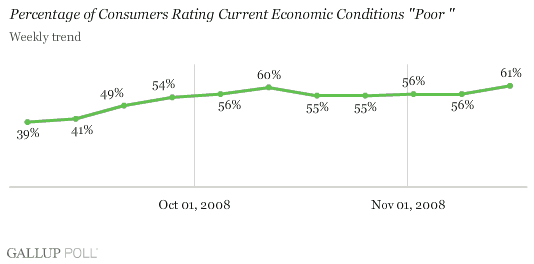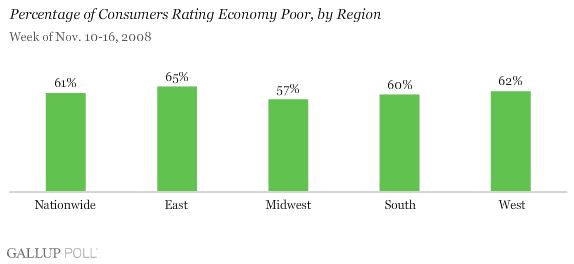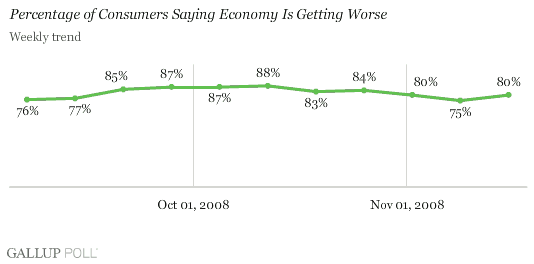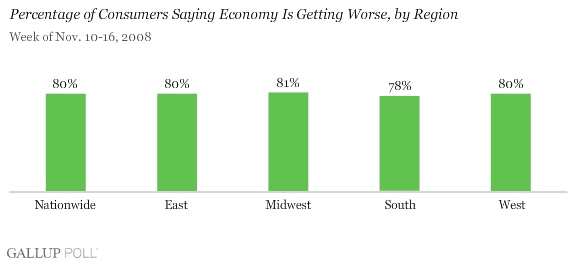PRINCETON, NJ -- Consumer confidence, after improving slightly in late October and early November, has now returned to its mid-October level. The percentage of consumers reached a weekly high of 60% during the week ending Oct. 12; this highly negative sentiment moderated in the 55% range over the next four weeks, culminating in election week. However, consumer assessments of the economy deteriorated significantly once again last week, with 61% rating the economy poor -- a new weekly high.

More Americans Rating Economy "Poor"
, it seemed as though plunging gas prices and stabilizing credit markets were combining with something of a President-elect Barack Obama "halo effect" to suggest was improving -- at least on the margin. However, even as pump prices have continued to decline, it seems the positive impact of Obama's victory has been short-lived at best. The percentage of Americans rating the economy "poor" last week ranged from 57% in the Midwest to 65% in the East.

More Americans Saying Economy Is "Getting Worse"
peaked in mid-October at 88%, and seemed to be gaining positive momentum during the week of President-elect Obama's election victory as it hit 75%. However, it has since reversed course once more, rising to 80% last week. Essentially 8 in 10 Americans in each region of the country told ÆéûÜǨû§last week that economic conditions are getting worse, rather than better.


Commentary
Since the election, it has become clear that President-elect Obama does not intend to rush to fill the current economic leadership vacuum; instead, he is waiting to do this until January, when he takes office. Not only has he stated his position that the United States has only one president at a time, but he has yet to name his administration's new Treasury secretary and has appeared to make little effort to provide leadership for the lame-duck Congress. Although these positions are consistent with U.S. traditions, they most likely have limited any potential consumer and/or investor confidence "halo effect" associated with the Obama victory.
At the same time, Treasury Secretary Paulson announced that he no longer plans to use bailout funds to purchase troubled assets. In turn, this change in policy may have created fears of added asset writedowns on the part of the nation's financial institutions. Almost simultaneously, Paulson told lawmakers he would not provide automakers with bailout funds. As a result, recent assumptions that the financial-sector crisis was easing are now back in doubt.
Add to all of this surging unemployment, a worsening outlook for Christmas sales, plummeting equity markets, and a continuing consumer credit crunch, and it is no surprise that consumer confidence is deteriorating. It appears the economic leadership challenge facing the new administration early next year is getting greater as every week passes.
Survey Methods
ÆéûÜǨû§is interviewing no fewer than 1,000 U.S. adults nationwide each day during 2008. The economic questions analyzed in this report are asked of a random half-sample of respondents each day. The results reported here are based on combined weekly data from 3,543 interviews, conducted Nov. 10-16, 2008. For results based on this sample, the maximum margin of sampling error is ôÝ2 percentage point.
Interviews are conducted with respondents on land-line telephones (for respondents with a land-line telephone) and cellular phones (for respondents who are cell-phone only).
In addition to sampling error, question wording and practical difficulties in conducting surveys can introduce error or bias into the findings of public opinion polls.
